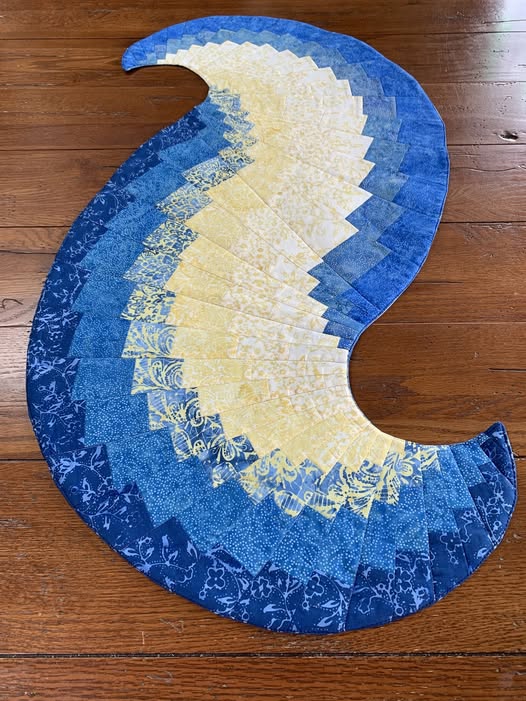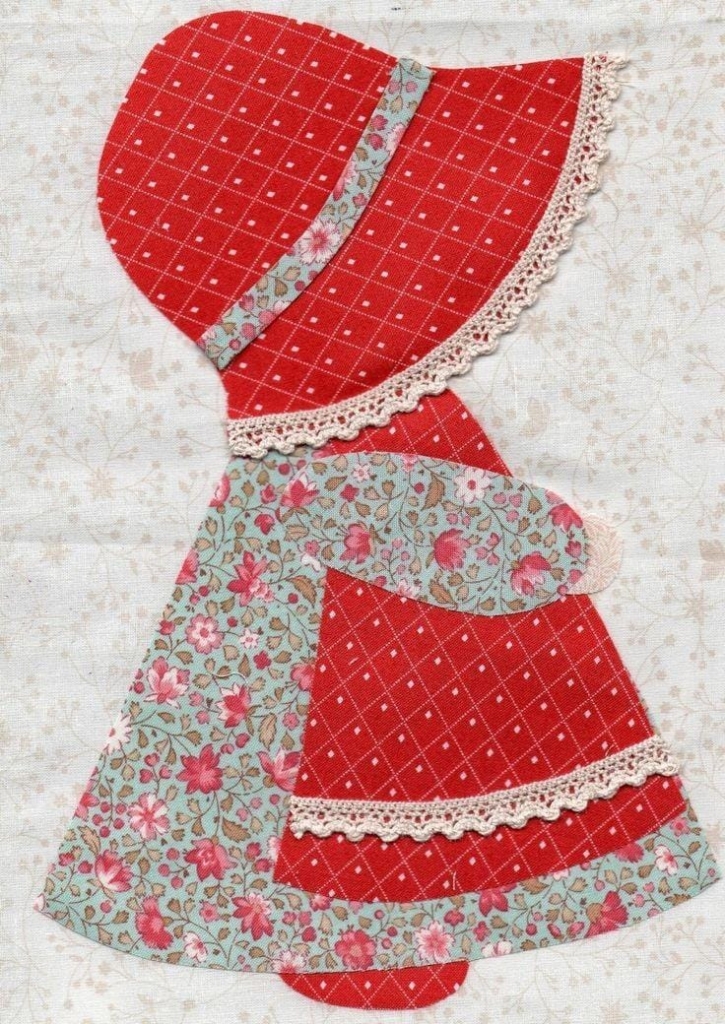
Sunbonnet Sue Block is one of the most beloved and timeless quilt patterns in the world of sewing and patchwork. Known for its charming depiction of a girl wearing a bonnet and dress, this pattern has been adored by generations of quilters for its nostalgic and heartwarming design.
The Sunbonnet Sue Block represents innocence, simplicity, and the joy of handmade art. It’s a classic motif that continues to inspire both beginners and experienced quilters around the world.
Creating a Sunbonnet Sue Block is not only a creative process but also a sentimental journey through quilting history. The pattern dates back to the late 19th century, becoming a symbol of traditional American quilting.

What makes this block truly special is its versatility—you can use it to create quilts, pillows, wall hangings, or even tote bags. Each block can be personalized with different fabrics, colors, and stitching styles, making every creation a unique piece of textile art.
In this Sunbonnet Sue Block tutorial, we’ll explore how to make this adorable design step by step. You’ll learn what materials you need, how to assemble each piece, and how to add finishing touches that bring your Sunbonnet Sue to life. Whether you prefer classic pastel tones or vibrant modern fabrics, this guide will help you craft a project filled with charm, tradition, and personal expression.
Before you begin, gather all the materials and tools necessary to create your Sunbonnet Sue Block. Having everything ready will make your quilting experience smoother and more enjoyable. Fortunately, this project doesn’t require complicated supplies—just basic quilting materials and your imagination.
Start with fabric in several colors and patterns. You’ll need one for the background, one for the dress, one for the bonnet, and one for the shoes or other details. Cotton fabric works best because it’s easy to cut and sew. Choose prints and shades that complement each other for a harmonious look.
Next, prepare your sewing tools: scissors or a rotary cutter, pins, a sewing machine or needle and thread for hand stitching, and an iron for pressing your seams. You’ll also need fusible web or fabric glue if you plan to use the appliqué method to attach your pieces. This will help keep your fabric shapes secure while you stitch around them.
A printed Sunbonnet Sue Block pattern template is essential to ensure accuracy. You can find free templates online or draw your own if you enjoy customizing the design. Don’t forget a cutting mat and ruler for precise cutting. Finally, have some embroidery floss or decorative thread on hand to add small details like outlines, flowers, or facial features if desired.
Once you’ve gathered all your materials, you’re ready to start crafting your charming Sunbonnet Sue Block.
Now that you have your materials ready, it’s time to create your Sunbonnet Sue Block. This process involves layering fabrics, cutting shapes, and stitching them together to form the iconic image of Sunbonnet Sue. Follow these steps carefully to achieve the best results.
Step 1: Prepare Your Background Fabric.
Cut a square of fabric for your background, usually around 10 to 12 inches. Press it flat to remove any wrinkles, ensuring a smooth surface for your design.
Step 2: Cut Out the Pattern Pieces.
Using your printed template, trace the bonnet, dress, shoes, and any other desired elements onto your chosen fabrics. Carefully cut each piece and arrange them on your background fabric.
Step 3: Assemble the Design.
Position the bonnet on top of the head area, then layer the dress below it. Arrange the shoes and any accessories like a flower or basket. Adjust until you’re happy with the composition.
Step 4: Fuse or Pin the Pieces.
If you’re using fusible web, iron your pieces in place following the manufacturer’s instructions. If you prefer hand sewing, pin the pieces securely before stitching.
Step 5: Stitch the Edges.
Use a blanket stitch or zigzag stitch to sew around each fabric piece. This not only secures your design but also adds a decorative touch. For a traditional look, use contrasting thread colors.
Step 6: Add Decorative Details.
Use embroidery floss to outline parts of the design or to add embellishments. A few flowers, a basket, or tiny patches of grass can give your Sunbonnet Sue Block extra charm and personality.
The Sunbonnet Sue Block offers endless opportunities for creativity. Each quilter can add their own style and emotion to the design, turning a classic block into something truly unique.
You can make a traditional Sunbonnet Sue with soft pastel fabrics or experiment with bold, modern prints for a fresh take. Try creating a series of blocks with different color schemes to tell a story or represent the seasons.
Adding themed accessories can also bring your blocks to life—consider giving Sunbonnet Sue a parasol, a basket of flowers, or even a small pet. Embroidered details like ruffles, bows, or buttons can add extra texture and depth.
You might also play with the background fabric. A patchwork sky, floral field, or geometric pattern can completely change the mood of your quilt. Don’t be afraid to combine hand embroidery with machine stitching for a mix of traditional and modern techniques.
Finally, once you’ve created several Sunbonnet Sue Blocks, you can join them together into a beautiful quilt top. Use sashing and borders that complement your chosen color scheme. The result will be a one-of-a-kind handmade treasure full of love and craftsmanship.
Creating a Sunbonnet Sue Block takes patience and attention to detail, but a few simple tips can make your work neater and more enjoyable.
Always press your fabrics before and after cutting. This keeps your pieces flat and helps ensure accurate seams. Use sharp scissors or a rotary cutter for clean edges. When using fusible web, remember to cut just inside your traced lines to avoid visible outlines after fusing.
Experiment with different stitch types to see what you like best. Blanket stitch provides a classic, handmade look, while a zigzag stitch is durable and quick. For hand appliqué, small invisible stitches give a delicate finish.
Keep your color palette balanced—too many bold prints can distract from the design. Try mixing solids and patterns for visual interest without overwhelming the main figure.
If you’re making multiple blocks, work assembly-line style by cutting all your pieces at once. This saves time and ensures consistency across your quilt. And remember, small imperfections only add charm and authenticity to your handmade work.
1. What is the origin of the Sunbonnet Sue Block?
The Sunbonnet Sue design originated in the late 1800s and became popular in American quilts during the early 1900s. It was inspired by illustrations of little girls in bonnets and became a symbol of simplicity and innocence.
2. Can beginners make a Sunbonnet Sue Block?
Yes! The Sunbonnet Sue Block is beginner-friendly, especially when using the fusible appliqué method. It’s a great way to practice fabric cutting, placement, and decorative stitching.
3. What size should each block be?
Traditional blocks range from 8 to 12 inches, but you can adjust the size depending on your project. Smaller blocks are perfect for pillows, while larger ones suit quilts or wall hangings.
4. Can I use scrap fabric for this project?
Absolutely! The Sunbonnet Sue Block is an excellent scrap-busting project. Mixing different fabric remnants adds charm and individuality to each block.
5. How can I make my Sunbonnet Sue unique?
Try changing the color palette, adding embroidery details, or giving your character accessories like flowers or a hat. Each variation makes your quilt more personal and creative.
6. Is hand sewing better than machine sewing for this block?
Both methods work well. Hand sewing gives a traditional, vintage feel, while machine sewing is faster and creates strong, even stitches.
Creating a Sunbonnet Sue Block is a beautiful way to celebrate quilting tradition while expressing your creativity. This timeless design captures warmth, nostalgia, and the artistry of handmade crafts.
By following the steps and tips in this guide, you can make your own version of this classic pattern and keep the spirit of quilting alive. Try different fabrics, colors, and embellishments to make your Sunbonnet Sue truly yours.
Share your creations proudly and don’t forget to leave your honest opinion and suggestions—I’d love to hear about your experience and ideas for future quilting projects!
